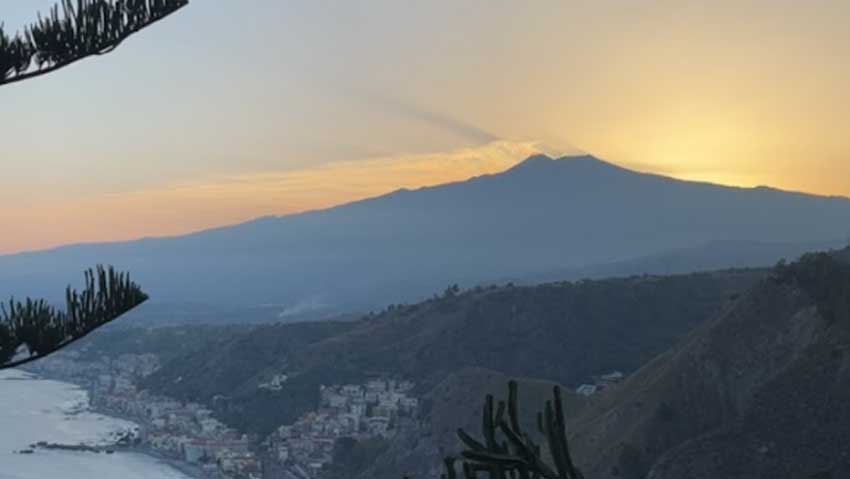
Sicily is nothing but a dream - from the food to the spectacular coastline to the wine. Whether you’re visiting this island in person or through your glass, you must travel to Etna where the wines are just as bewitching as the majestic Mount Etna that defines the region.
Right now, the Etna wine region is becoming just as hot as the lava bubbling in this active volcano. That’s not just because these wines are ridiculously divine and diverse (from zippy white wines to complex reds) but because they’re also a great steal for their quality. Many even go as far as to say that Etna Rosso is the Burgundy of the Mediterranean. Need we say more?
Need we say more? Yes, we do! Let’s explore all the things you need to know about Etna wines, from the grapes to land to the wines you should be ordering now.
The Location
 One of the most impressive details about this region is its proximity to an active volcano - Etna. This incredible natural wonder is located between Catania and Messina on the eastern coast of Sicily. Mount Etna is actually a World UNESCO Heritage site.
One of the most impressive details about this region is its proximity to an active volcano - Etna. This incredible natural wonder is located between Catania and Messina on the eastern coast of Sicily. Mount Etna is actually a World UNESCO Heritage site.
Even more fascinating is the winemaking happening right in the foothills of Etna. Vineyards hug Etna like a necklace from the East, taking advantage of the volcano and the sea.
Viticulture isn’t a new thing here, might we add. Grape growing as well as winemaking has been around for thousands of years in Etna. Nevertheless, it wasn’t until the last 40 or so years that the impressive Etna wines we see today came to fruition. We must thank Giuseppe Benanti and Salvo Foti for this, two pioneers of growing indigenous grapes in Etna’s incredible soil.\
The Terroir
You might be wondering - how do you grow things right by a volcano? Must be dangerous right? Well, in many respects, it is. But, there is a blessing in disguise here - the rich layers of volcanic soil that do magic for vines.
The land around Etna features an incredible combination of fine ash, hardened lava, and sand (remember, we are on an island). While the precise soil composition does shift depending on where you are, generally you will find one or all of these factors in the soil.
What elevates this incredibly unique soil composition is the altitude of these vineyards. Etna vineyards typically rest anywhere between 300 to 1000 meters above sea level (about 1000 to 3300 feet.) While high altitudes may produce some stellar wines, the vines and winemakers have to do a lot of work to ensure their wines reach their potential. Etna sees a lot of rain, and the higher the altitude, the harder managing rainfall gets. Plus, with Sicily’s blistering heat, being closer to the sun doesn’t help either. But, Etna’s porous volcanic soil is the savior, draining the excess rain and lending the wines a brilliant mineral character you can’t find anywhere else.
The Grapes
Etna’s intense terroir is simply best suited for the area’s local grapes. And, these local grapes are truly something special.
The two main stars of Etna wines are Carricante and Nerello Mascalese. Both varietals are centuries old, but their histories are quite hazy. Carricante is the main white wine grape in Etna Bianco wines. It has a mind-blowing level of acidity and complex character. Then, there’s Nerello Mascalese, a tannic grape behind the irrefutable elegance of Etna Rosso wines that reminds many of Barolo or Burgundy wines.
Other grapes play supporting roles in Etna. The two to know are Cataratto - a white wine grape found in Etna Bianco wines - and Nerello Cappuccio - a red wine grape in Etna Rosso wines.
Now, here's a fun fact: What’s even more astounding is just how old some of the vines supporting these grapes are. You can find vines over 250 years old, which you will not find in many other parts of Italy or even Europe.
Why? The volcanic soils of Etna protected the vines through the major phylloxera outbreak in the 19th century, which destroyed vines throughout Europe. This turned Etna into the main artery for wine production for all of Europe, all the way up until the World Wars began.
 Etna Rosso
Etna Rosso
If there’s a wine taking the main stage, it's Etna Rosso. Whether you’ve seen it on a wine list yet (or not), it's bound to make it there. Because this region is hot.
What makes Etna Rosso wines so desirable is their expressiveness and inexpensiveness. First, Etna Rosso wines are predominantly Nerello Mascalese (at least 80% according to the DOC rules), a grape delicate in color with refined aromas of cherry and earth. And, if this character sounds familiar, don’t be surprised - Etna Rosso wines are actively compared to the Pinot Noirs of Burgundy or even the Nebbiolos of Barolo.
This credit goes to the almighty Nerello Mascalese grape and how it gracefully expresses Etna’s volcanic terroir. Of course, we must mention its cousin Nerello Cappuccio, which makes up a maximum of 20% of Etna Rosso blends, lending color and softness to Mascalese’s brooding character.
The price points on these wines will surprise you, especially since many vintages can age beautifully. Combined with Etna’s impressive hand-harvested vineyards and winemaking traditions, these wines give you so much for your money.
Etna Bianco
Lingering slightly in the shadows of Etna Rosso are Etna Bianco wines. We say this because - while this region is gathering much attention - it is led by the reds. Yet, this makes for an incredible opportunity for wine lovers to take advantage of all the Etna Bianco wines (and their killer prices) before the secret is out.
So, what makes Etna Bianco just so good? Well, we have to thank Carricante and Cataratto, the two local grapes that give this white wine all its character. Carricante makes up at least 60% of the Etna Bianco blend and Cataratto no more than 40%.
Etna Bianco is a very evocative wine. Typically, these wines have brilliant acidity and intriguing salty quality. Their flavors can range from lemon to honey, which is often complimented by a flinty, smoky undertone, a little gift from their volcanic terroir.
Yet, Carricante is a bit of a shy wine in the beginning. Just like their red counterpart, these wines can age. Let’s put it this way - Carricante gives Chardonnay a run for its money when it comes to age-able white wines. Sure, there are Etna Bianco wines out there you can sip now - at excellent prices - and will also be mind-boggling spectacular in 5 years if you have the patience to wait.
Excited to try Etna wines? We sure hope so. Our Big Hammer team is enamored with this region. If you have any questions about Etna wines, never hesitate to reach out. We love to share our love for Italian wine.
Wines to Try
Girolamo Russo ‘Nerina’ Etna Bianco DOC
I Vigneri di Salvo Foti Palmento Caselle Etna Bianco DOC Superiore
I Custodi delle Vigne Etna ‘Ante’ Etna Bianco
Masseria Setteporte Etna Rosso DOC
Benanti Etna Rosso DOC
Tenuta Tascante 'Ghiaia Nera' Etna Rosso DOC


